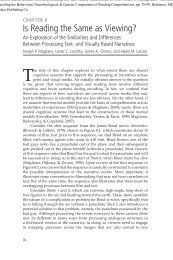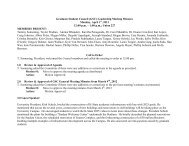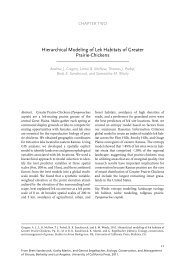Status Report, Vol. 36, No. 7, July 28, 2001 - Insurance Institute for ...
Status Report, Vol. 36, No. 7, July 28, 2001 - Insurance Institute for ...
Status Report, Vol. 36, No. 7, July 28, 2001 - Insurance Institute for ...
You also want an ePaper? Increase the reach of your titles
YUMPU automatically turns print PDFs into web optimized ePapers that Google loves.
<strong>Status</strong> <strong>Report</strong>, <strong>Vol</strong>. <strong>36</strong>, <strong>No</strong>. 7, <strong>July</strong> <strong>28</strong>, <strong>2001</strong> 5<br />
in “passive” safety features in vehicles. But<br />
the standards also included requirements<br />
<strong>for</strong> active safety features such as lap/<br />
shoulder belts. The passive features that<br />
required no action on the part of occupants<br />
included energy-absorbing steering<br />
columns, laminated windshields, side door<br />
beams, etc. Such features have saved thousands<br />
of lives, as have federally mandated<br />
lap/shoulder belts.<br />
“<strong>No</strong> other country pursued the passive<br />
strategy as vigorously,” Gladwell claims.<br />
Yet a few years after the introduction of<br />
the first new vehicle safety standards<br />
in the United States during<br />
the late 1960s and early<br />
1970s, almost identical vehicle<br />
standards were adopted in Canada,<br />
Europe, and Australia.<br />
What Gladwell fails to mention is that at<br />
the same time the U.S. Congress passed<br />
the legislation that authorized federal vehicle<br />
safety standards, it passed companion<br />
legislation to establish standards <strong>for</strong> state<br />
highway safety programs. As head of the<br />
first federal highway safety bureau, Haddon<br />
issued 13 such standards that addressed<br />
issues including alcohol-impaired<br />
driving, driver licensing, and motorcycle<br />
helmet use. This was part of the balanced<br />
approach — addressing road users and vehicles<br />
— that Haddon strongly believed in.<br />
way safety programs. Today only 21 states<br />
have motorcycle helmet use laws.<br />
This one example illustrates why some<br />
other countries have been more successful<br />
than the United States in reducing some<br />
kinds of motor vehicle crash deaths and<br />
injuries. While U.S. states were repealing<br />
helmet use laws, other countries, which already<br />
had helmet laws, were adopting seat<br />
belt use laws. This was not because Haddon<br />
and his colleagues had no interest in<br />
such measures. In fact, Haddon endorsed<br />
seat belt use laws after research funded by<br />
Motorcycle helmet use was a focus of 1 of the 13 safety standards addressing road users<br />
that Haddon issued when he headed the federal highway safety bureau. Such standards<br />
were part of the balanced approach that Haddon strongly believed in.<br />
(Road design standards weren’t included<br />
only because they’re administered by a different<br />
federal agency.)<br />
One of the federal highway safety standards<br />
issued at Haddon’s behest required<br />
all states to adopt motorcycle helmet use<br />
laws. By the early 1970s, all but three<br />
states had such laws covering all riders.<br />
But then politicians in Cali<strong>for</strong>nia (one of<br />
the states without laws) challenged this requirement,<br />
and the challenge led to the<br />
demise of federal standards <strong>for</strong> state high-<br />
the <strong>Institute</strong> in 1972 demonstrated the effectiveness<br />
of the world’s first belt use law<br />
in Victoria, Australia. The erosion of effective<br />
highway safety programs aimed at<br />
road users occurred because state politicians<br />
refused to show leadership, not because<br />
of Haddon’s ideology.<br />
Gladwell correctly points out that in<br />
the 1970s many countries followed the<br />
lead of Victoria and adopted belt use laws.<br />
He then claims that “a similar movement in<br />
the United States in the early seventies

















